Summary
Burn injuries in both developed and developing countries cause long-term disability, mortality, and socio-economic costs that are imposed on patients, families, and societies. This study was carried out to investigate the epidemiology, outcome, and cost of hospitalization of 388 burn patients admitted to the Imam Khomeini Hospital Burn Center in Kermanshah, Iran, between 21 March 2011 and 20 March 2012. The data about demographics, cause of burns, degree of burns, outcome of burns, burned body surface (BBS), length of stay (LOS), and cost of hospitalization were collected by reviewing medical records and analysed by SPSS 16. The patients’ mean age was 27 years. The male/female ratio in burn patients was 1.14/1. The mean BBS was 36.06%. The mean LOS was 9.04 days. Flame (67.0%) and hot liquids (21.9%) were the major causes of burn. Burn injuries were more common in the upper limbs (81.4%), lower limbs (70.9%), and head and neck (65.2%). 11.6% of patients had all the regions involved. The fatality rate was 18.8%. The mean cost per patient was 20,463,227 Iran Rials (IRR). The cost per one percentage of burn and one day of hospitalization was 562,632 IRR and 2,263,631 IRR, respectively. The main factors relevant to death were identified including the extent of burn, gender, age, causes, and degree of burn. In addition, LOS proved to have a higher impact on costs than burn percentage.
Keywords: epidemiology, cost, burn, Kermanshah, Iran
Abstract
Les brûlures, soit dans les pays développés soit dans ceux en développement, causent des invalidités à long terme, des décès et des coûts socioéconomiques imposés aux patients, aux familles et aux sociétés. Cette étude a été réalisée pour évaluer les résultats et les coûts de l'hospitalisation de 388 patients brûlés admis au Centre des Brûlés chez l'hôpital Imam Khomeini à Kermanshah, Iran, entre le 21 mars 2011 et le 20 mars 2012. Les données sur les caractéristiques démographiques, les causes des brûlures et leur degré, les résultats finaux, la surface corporelle brûlées (SCB), la durée du séjour hospitalier (DSH) et le coût de l’hospitalisation ont été recueillies moyennant l’examen des dossiers médicaux et analysées par SPSS 16. L'âge moyen des patients était de 27 ans. Le sex ratio homme / femme chez les patients brûlés était de 1,14/1. La SCB moyenne était de 36,06%. La DSH moyenne était de 9,04 jours. Les flammes (67,0%) et les liquides chauds (21,9%) étaient les principales causes des brûlures, qui se produisaient avec majeure fréquence aux membres supérieurs (81,4%), aux membres inférieurs (70,9%) et à la zone tête/cou (65,2%). Dans 11,6% des cas toutes les régions corporelles étaient intéressées. Le taux de la mortalité était de 18,8%. Le coût moyen par patient était de 20.463.227 Rials iraniens (IRR). Le coût par point de pourcentage de brûlure et par journée d'hospitalisation était de 562.632 IRR et de 2.263.631 IRR, respectivement. Les principaux facteurs pertinents à la mort ont été identifiés, notamment l’extension de la brûlure, le sexe, l'âge, les causes et le degré de brûlure. En outre, nous avons trouvé que la DSH causait un impact plus important sur les coûts que le pourcentage de brûlure.
Introduction
The consequences of burns such as death, long-term disabilities and social-economic costs are imposed on patients, their families, and society.1,2 Studies have revealed that at least 5% of the total number of in-patients at any given time and over 1% of the global burden of disease are related to burn injuries.3,4 The factors associated with burn injuries vary widely in different regions and therefore a successful preventive programme should be designed according to the needs of each region.5 In the United States, 1.25 million people are hospitalized annually due to burns, with an overall cost to society of 7 billion US dollars.6
Healthcare services provided for burn patients are among the most costly; nevertheless, few studies have been conducted to investigate the cost of burn patients, and no study was published in Iran during the course of our study.2,7,8
Although a comprehensive and precise calculation of costs of burn patients is a difficult task, these studies are necessary in order to evaluate the economic efficiency of these services. Moreover, these studies would provide a financial perspective for patients, hospital administrators, and health policy makers. The few existing studies on cost analysis of burns patient have been carried out in other countries,2,7,9 and we could not find any study published in the literature related to the costs of burns in Iran. The aim of this study was to investigate the epidemiology, outcome, and hospitalization direct costs of 388 burn patients who were admitted to the Imam Khomeini Hospital burn centre in the province of Kermanshah, Iran, in 2011.
Material and methods
Four hundred and one burn patients were admitted between 21 March 2011 and 20 March 2012 to the Imam Khomeini Hospital Burns Centre, Kermanshah, Iran, which is the only referrals centre for major burns in the province of Kermanshah. Of all patients, 13 were excluded due to concomitant diseases or as referrals from other burn centres. Eventually, the data regarding 388 patients were analysed. The amounts of costs were reported in IRR (1 dollar = 15,000 IRR at the time of the study).
The data regarding patients’ age, gender, season of burns, causes of burn, burned body surface (BBS), degree of burn, outcomes of burn, place of burn, length of stay (LOS), and hospital costs (including drug and other consumable items, nursing services, diagnostic services, visits, hotel accommodation, blood banks, surgery, etc.) were collected by reviewing medical records. The statistical analysis was performed using SPSS Version 16.
Results
The mean and median age were 27 and 25 years, respectively (ages ranged from less than 1 to 83 yr). About 80% of patients were aged 40 or less. The male/female ratio was 1.14/1 (207 males and 181 females) (Table I). The distribution of the 388 patients by age group and gender is also shown in Table I.
Table I. Distribution of patients by age group and gender.
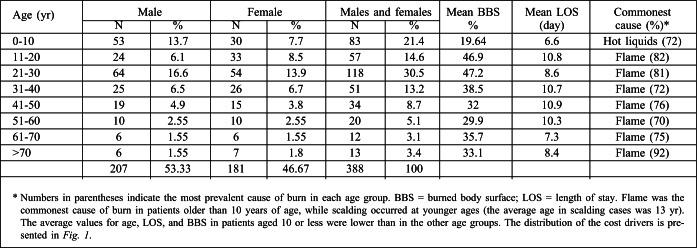
The main cost drivers were associated with drugs and other consumable items (52% of total costs), hotelling (34%), and patients’ consultations (5%). The distribution of cost drivers for males and females was similar.
Fig. 1. Distribution of cost drivers for all patients.
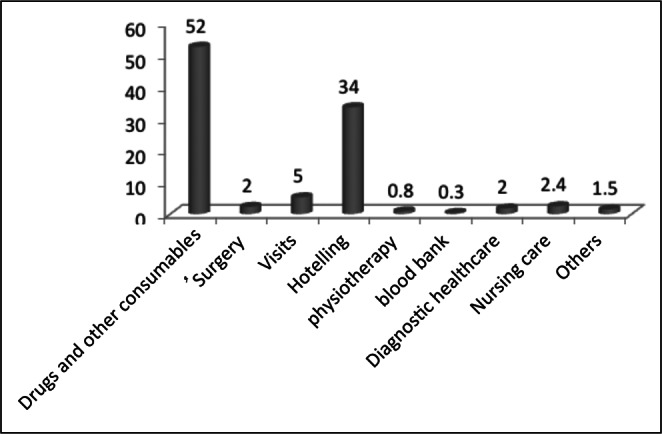
Causes of burns
The most frequent causes of burns were flame (67%) and hot liquids (21.9%) (Table II).
Table II. Distribution of burn patients by cause.

About 68% of burns by hot liquids were associated with less than 20% BBS, and about 90% of burns by explosion with less than 40% BBS. Burns by electricity were more common in males (about 85%) and the highest fatality rate was associated with burns by flame (0.265) and explosion (0.125).
The distribution of costs by cause of burn is presented in Table III.
Table III. Distribution of cost drivers by causes of burn (percentage).

The average cost per patient burned by flame and hot liquids was respectively 21,968,055.8 IRR and 19,554,674.5 IRR. For all causes of burns, the highest percentage of costs was related to drugs and other consumable items, hotelling, and consultations. The mean LOS and BBS caused by flame were respectively 10.33 days and 43.7%.
LOS
The mean and the median LOS were 9.04 and 5 days, and the range of LOS varied from less than 1 day to 56 days. The mean and the median of LOS for females (10.3 and 6 days) were higher than for males (7.9 and 4 days). The mean LOS for patients who died was 5.03 days, which was lower than in patients who survived. The average cost of patient per hospitalization day was 2,263,631 IRR and was higher in females than in males. The average cost for males and females was 19,113,198 IRR and 22,007,182 IRR, respectively.
BBS and the degree of burn
The mean and median BBS were 36.906 and 25%. The range of BBS varied from 0.6% to 100%. About 68% of patients had a BBS lower than or equal to 40%, and only 12% of the patients had a BBS above 40%. The distribution of patients according to the BBS and degree of burn is presented in Table IV.
Table IV. Distribution of patients by the BBS and degree of burn.

The mean and the median of burns in deceased patients were respectively 77.4% and 80%, with a standard deviation of 20.6. In 80% of the patients who died, the BBS was 60% or greater. The fatality rates for the patients with a BBS lower than or equal to 60% and over 60% were 0.048 and 0.734, respectively. The mean LOS for patients with a BBS lower than or equal to 60% and over 60% were 9.86 and 5.7 days, respectively. The mean LOS for second- and third-degree burns was 13.6 days, followed by third-degree burns (8.5 days) and second-degree burns (5.5 days). The mean LOS for both second- and third-degree burns was about 13.6 days, while for second- and third-degree burns it was 8.5 and 5.5, respectively. The distribution of costs by BBS is presented in Table V.
Table V. Distribution of costs by BBS (percentage).

The highest average cost was associated with patients with 21-40% BBS, amounting to 23,489,267 IRR. The mean LOS for this group of patients was higher than for other patients. The average cost per one per cent of burns in all patients was 5,667,477 IRR. The fatality rate for all patients was 0.188, and higher in females than in males. The mean and median ages in patients who died were 31.9 and 26 yr, respectively. The distribution of the cost of drivers for deceased and surviving patients is shown in Figs. 2 and 3.
Fig. 2. Distribution of costs for deceased patients.
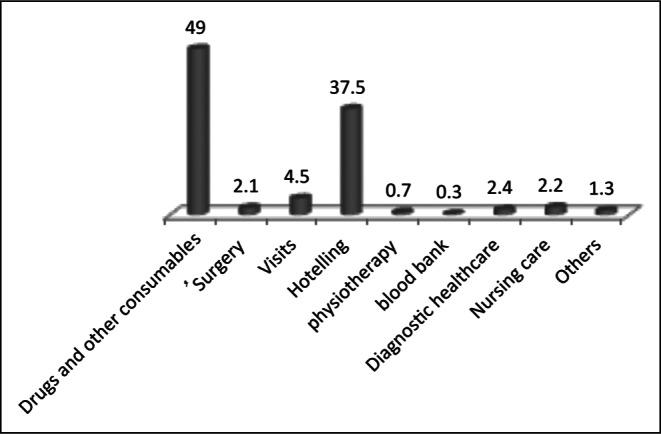
Fig. 3. Distribution of costs in surviving patients.
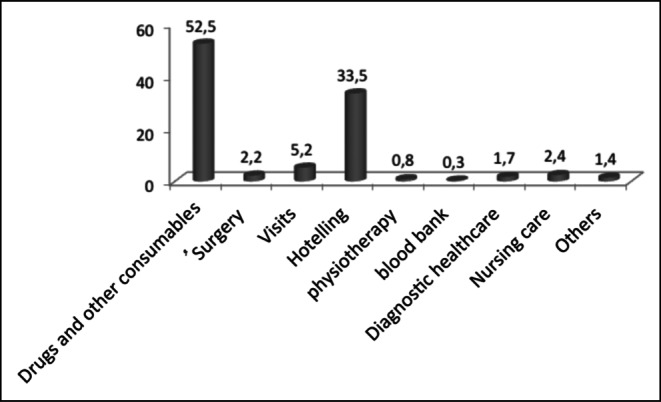
The average cost and percentage of burn per deceased patient were 19,420,095 IRR and 77.4%. For surviving patients the cost amounted to 20,704,968 IRR and 9.97%. In both deceased and surviving patients, the main cost drivers consisted of drugs and consumable items, and hotelling, although the costs of hotelling for deceased patients included a lower percentage of total costs than for surviving patients as a consequence of their shorter LOS.
The mean of the number of services is shown in Figs. 4. The highest number of services pertained to diagnostic services as well as to drugs and other consumables.
Fig. 4. Distribution of number of services by type of service.
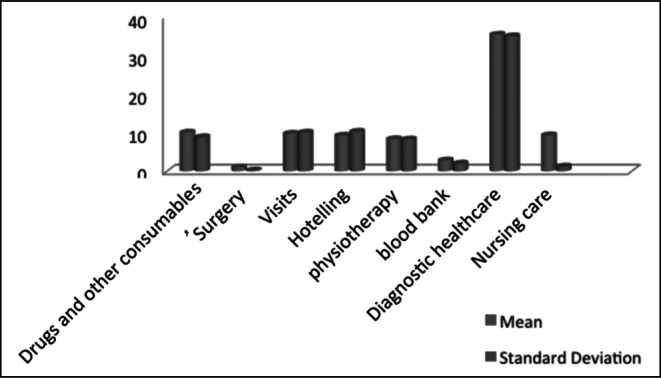
The site of burns by body organ is presented in Table VI. The commonest sites were the upper limbs (81%), the lower limbs (70.9%), and the head and neck (65.2%).
Table VI. Distribution of sites of burn by body organ*.
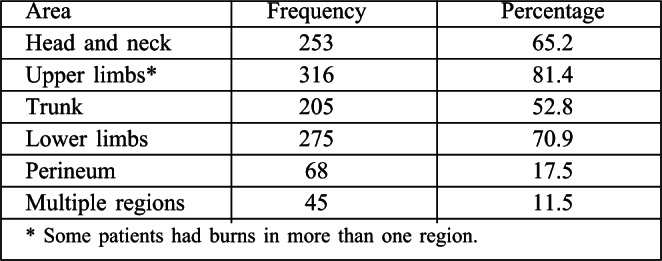
The highest number of burns occurred at home (60.7%), followed by work places (28.5%); in 11.3% of cases the burn occurred in unspecified surroundings. The highest number of burns occurred in the summer months (29.4%), followed by winter (26.8%), autumn (24%), and spring (19.8%). The average cost per patient in spring was 22,996,965 IRR, higher than in the other seasons. The average LOS and the mean BBS for patients in spring were respectively 10.1 days and 38.6, and they were higher than in the other seasons.
The distribution of the patients by geographic region is shown in Figs. 5.
Fig. 5. Distribution of patients by geographic region.
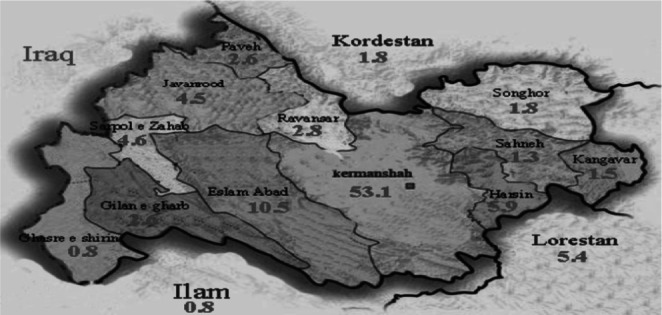
By geographical region, the highest percentage of burns was recorded in Kermanshah City (53.1%), followed by Eslam Abad (10.5%) and Harsin (5.9%), while 8% of patients came from neighbouring provinces (Lorestan, Kurdistan, and Ilam).
The main burn patient mortality factors are presented in Table VII.
Table VII. Factors of mortality in burn patients.

The main factors of mortality in these patients were identified as BBS > 40%, age (yr) > 20, female gender, flame burns, and degree of burn.
Discussion
Factors associated with burn injuries are highly varied between different regions; therefore, epidemiologic studies about burn patients in each region are required before designing and performing an effective preventive programme. The analysis of the demographic data revealed that the age group from 20 to 30 years was the most susceptible to burn injuries, which is consistent with findings from previous studies.10-12 Furthermore, the results demonstrated that males were more likely to be at risk of burn injuries than females, due to their working away from home, and this also was compatible with other studies.13-16 In all age groups, flame was the major cause of burn, except for the age group under 10, where hot liquids were the main cause, and other studies revealed the same findings. 17-20 Moreover, most burns caused by electricity (electric shock) occurring to males were due to their working conditions and higher exposure to risk factors for burns. In the younger age groups most burns occurred by hot water. Mothers should be made aware of these kinds of accidents. Consequently, appropriate preventive programmes can help by educating people via the media (television, radio, and newspapers).
The mean and median LOS were 9.04 and 5 days respectively, which were consistent with some studies,21,16 although higher than another study.22 The mean LOS of female patients was significantly longer than for male patients, as in other studies.16 The mean BBS was 36.06, which was similar to another study,18 but different from others.19-23 The analysis of hospital data revealed that no self-immolation was recorded in the medical records since no insurance coverage was provided for the costs of hospitalization in case of self-injury; the burns were therefore unintentional.
The mean cost per patient, BBS, LOS, and the fatality rate by flame were higher than for other causes. In addition, the relationship between the cause of burn and the BBS and LOS was significant (p < 0.0001). The prevalent season of burns was summer, possibly because it was the time of outdoor activities and travelling, as in previous studies.20 The results of this study revealed that BBS > 40%, age > 20, female gender, flame as the cause of burn, and degrees of burn were the main factors of mortality, thus confirming the findings of previous studies.1,21,24 The financial burden associated with the burn injuries in developed countries was higher than for other major health problems including cancer and AIDS.25,26 The review of the literature showed that no studies on cost analysis of burns existed in Iran until this study was conducted.
In this study, the average cost of burns per patient was 20,463,227 IRR. Sahin et al. found the average cost to be $15,250 per patient.2 Loftus found an average cost of $46,069 per patient.7 The costs of burn patient treatment varied greatly from country to country for many reasons, including admission and discharge policies, the quantity and quality of health care services, the prices of services and drugs, the wages of personnel, and different ways of calculating costs. The average cost for females was higher than for males, which could be due to the longer LOS and the higher average BBS for females. The review of medical records revealed that about 53.3% (1864.3 days) of the total days of LOS (3499.6 days) pertained to females in spite of the fact that they formed a smaller percentage of the whole number of patients.
This study had several limitations. First, it was conducted in a single burn centre in one city, and therefore cannot be generalized to other parts of the world. Second, costs were calculated from the provider’s viewpoint and they are less than the actual costs. Third, the costs did not include informal costs, productivity loss, transportation, food, etc.
Conclusion
This study provided a comprehensive perspective regarding the demographic characteristics, the factors associated with burns, and the cost of burn for patients, hospital administrators, and health policy makers. It also identified the main factors relevant to death such as burned body surface (BBS), gender, age, causes, and degree of burn. This study revealed that the length of hospitalization (LOS) influenced costs more than BBS. Facilitating the process of the reception and discharge of patients and improving the quality of health services at different levels can help to reduce LOS and hospitalization costs. In addition, most burns occurred at home, showing that women and children are two high-risk categories: attention should be focused on this aspect since such burns are preventable. Educational programmes for preventing burns, presented at appropriate moments using modern media, can efficiently reduce burn injuries.
Acknowledgments
All support and efforts of the Imam Khomeini Hospital staff, who sincerely collaborated during the work on the study, are much appreciated.
References
- 1.Panjeshahin MR, Rastegar Lari A, Talei AR, et al. Epidemiology and mortality of burns in the Southwest of Iran. Burns. 2001;27:219–26. doi: 10.1016/s0305-4179(00)00106-6. [DOI] [PubMed] [Google Scholar]
- 2.Sahin I, Ozturk S, Alhan D, et al. Cost analysis of acute burn patients treated in a burn centre: The Gulhane experience. Ann Burns Fire Disasters. 2011;24:9–13. [PMC free article] [PubMed] [Google Scholar]
- 3.Barret JP, Gomez P, Solano I, et al. Epidemiology and mortality of adult burns in Catalonia. Burns. 1999;25:325–9. doi: 10.1016/s0305-4179(98)00190-9. [DOI] [PubMed] [Google Scholar]
- 4.Leistikow BN, Martin DC, Milano CE. Fire injuries, disasters and costs from cigarettes lights, a global overview. Preventive medicine. 2000;31:91–9. doi: 10.1006/pmed.2000.0680. [DOI] [PubMed] [Google Scholar]
- 5.Ozbek S, Ozcan M, Selcuk A, et al. A retrospective epidemiological study of 385 burn patients hospitalized during 6 years in Bursa. Eur J Plast Surg. 2005;28:86–90. [Google Scholar]
- 6.Sanchez JLA, Pereperez SB, Bastida JL, et al. Cost-utility analysis applied to the treatment of burn patients in a specialized center. Arch Surg, 2007;142:50–7. doi: 10.1001/archsurg.142.1.50. [DOI] [PubMed] [Google Scholar]
- 7.Johnson KI, Meyer AA, Evans SK. Strategies to improve burn center utilization. J Burn Care Rehabil. 1988;9:102–5. doi: 10.1097/00004630-198801000-00026. [DOI] [PubMed] [Google Scholar]
- 8.Griffiths HR, Thornton KL, Clements CL, et al. The cost of a hot drink scald. Burns. 2006;32:372–4. doi: 10.1016/j.burns.2005.10.025. [DOI] [PubMed] [Google Scholar]
- 9.Tabiee SH, Nakhaee M. Epidemiology of burn patients in Imam Reza Hospital, Birjand, 1998-2002. Shahrekord University of Medical Sciences Journal. 2004;6:43–51. [Google Scholar]
- 10.Qader AR. Burn mortality in Iraq. Burns, 30 doi: 10.1016/j.burns.2011.12.016. Forthcoming 2012. [DOI] [PubMed] [Google Scholar]
- 11.Hosseini RS, Askarian M, Assadian O. Epidemiology of hospitalized female burns patients in a burn centre in Shiraz. Eastern Mediterranean Health Journal. 2007;13:113–8. [PubMed] [Google Scholar]
- 12.Andrew ED, Eshobo EI, Lilian OO, et al. A five-year review of burn injuries in Irrua. BMC Health Services Research. 2007;7:171. doi: 10.1186/1472-6963-7-171. doi:10.1186/1472-6963-7-171. [DOI] [PMC free article] [PubMed] [Google Scholar]
- 13.Mzezewa S, Jonsson K, Aberg M. A prospective study on the epidemiology of burns in patients admitted to the Harare burn units. Burns. 1999;25:499–504. doi: 10.1016/s0305-4179(99)00041-8. [DOI] [PubMed] [Google Scholar]
- 14.Ansari Lari M, Askarian M. Epidemiology of burn presenting to an emergency department in Shiraz, South Iran. Burns. 2003;29:579–81. doi: 10.1016/s0305-4179(03)00066-4. [DOI] [PubMed] [Google Scholar]
- 15.Chien WC, Pai L, Lin CC. Epidemiology of hospitalized burns patients in Taiwan. Burns. 2003;20:582–8. doi: 10.1016/s0305-4179(03)00133-5. [DOI] [PubMed] [Google Scholar]
- 16.Ekrami A, Hemadi A, Latifi M, et al. Epidemiology of hospitalized burns patients in Talaghani Hospital during 2003-2007. Bratisl Lek Listy. 2010;111:384–8. [PubMed] [Google Scholar]
- 17.Jamal YS, Ardawi MSM, Ashy ARA. Burn injuries in the Jeddah Area of Saudi Arabia: a study of 319 Patients. Burns. 1989;15:295–8. doi: 10.1016/0305-4179(89)90005-3. [DOI] [PubMed] [Google Scholar]
- 18.Bang RL, Ghoneim IE. Epidemiology and mortality of 162 major burns in Kuwait. Burns. 1996;22:433–8. doi: 10.1016/0305-4179(96)00015-0. [DOI] [PubMed] [Google Scholar]
- 19.Haberal M, Ucar N, Bilgin N. Epidemiological survey of burns treated in Ankara, Turkey and desirable burn-prevention strategies. Burns. 1995;21:601–6. doi: 10.1016/0305-4179(95)00044-c. [DOI] [PubMed] [Google Scholar]
- 20.Han TY, Kim JH, Yang MS, et al. A retrospective analysis of 19,157 burns patients: 18-year experience from Hallym Burn Center in Seoul, Korea. Burns. 2005;31:465–70. doi: 10.1016/j.burns.2004.11.014. [DOI] [PubMed] [Google Scholar]
- 21.Wai-sun H, Ying SY. An epidemiological study of 1063 hospitalized burn patients in a tertiary burns centre in Hong Kong. Burns. 2001;27:119–123. doi: 10.1016/s0305-4179(00)00095-4. [DOI] [PubMed] [Google Scholar]
- 22.Prem N. Sharma, Rameshwar L. Ban, Ahmad N, et al. Pediatric burns in Kuwait: Incidence, causes and mortality. Burns. 2006;32:104–11. doi: 10.1016/j.burns.2005.08.006. [DOI] [PubMed] [Google Scholar]
- 23.Rastegar Lari A, Alaghehbandan R, Nikui R. Epidemiological study of 3341 burns patients during three years in Tehran, Iran. Burns. 2000;26:49–53. doi: 10.1016/s0305-4179(99)00102-3. [DOI] [PubMed] [Google Scholar]
- 24.Groohi B, Alaghehbandan R, Rastegar Lari A. Analysis of 1089 burn patients in province of Kurdistan, Iran. Burns. 2002;28:569–74. doi: 10.1016/s0305-4179(02)00099-2. [DOI] [PubMed] [Google Scholar]
- 25.Lopez Bastida J, Serrano Aguilar P, Monton A, et al. The economic burden of stroke in Spain. Value Health. 2003;6:615. [Google Scholar]
- 26.Lopez Bastida J, Oliva Moreno J, Perestelo Perez L, et al. Determinants of health care costs in ambulatory patients living with HIV/AIDS. Value Health. 2005;8:A23. [Google Scholar]
- 27.Loftus J. Cost analysis of a major burn. NZ Med J. 1991;104:488–90. [PubMed] [Google Scholar]


